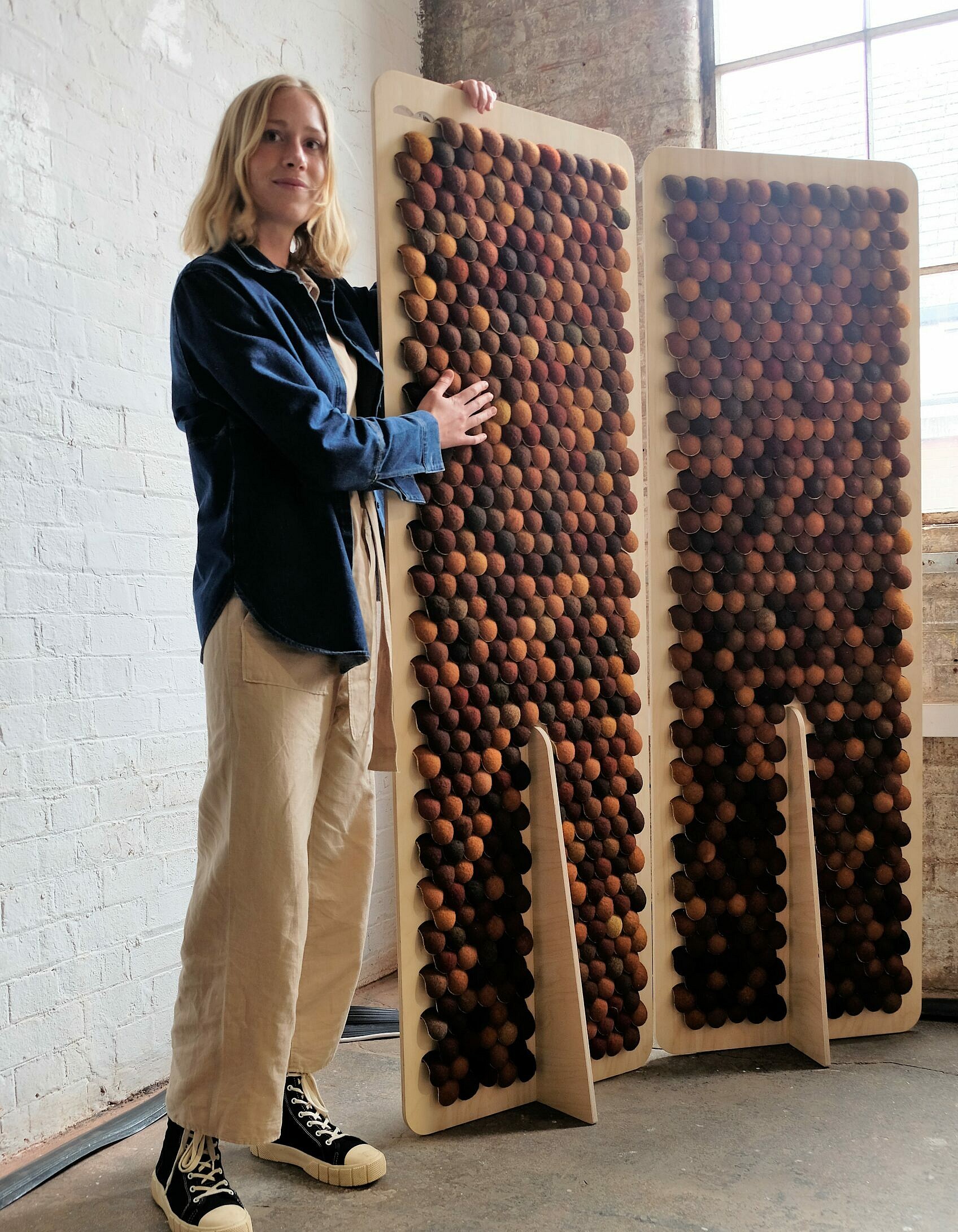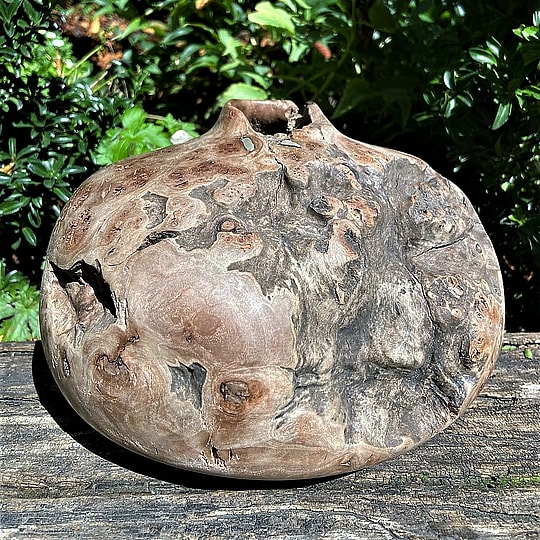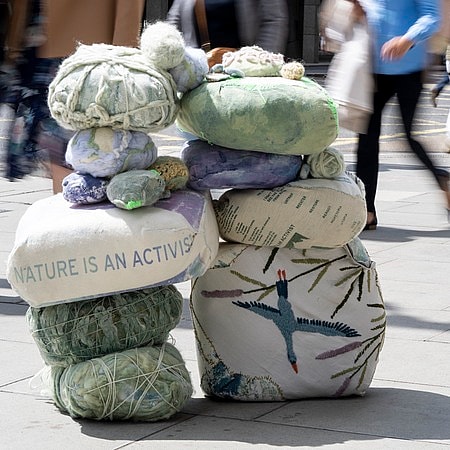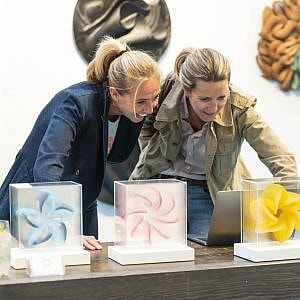Artefact – Green Grads
Green Grads is a platform nurturing recent graduates of UK universities confronting the world’s most pressing eco-issues, such as sustainability, climate change, waste and pollution, new materials, biophilia, bio-diversity and much more. Ten Green Grad makers with sustainability at the heart of their practice are exhibiting at Artefact.
“We fuel UK environmental action with new talent from UK universities”
Design Centre, Chelsea Harbour is the headline sponsor for Green Grads 2022/23.

AMBER THOMPSON: FLOC
Cloud-like shades of carded wool waste
Amber Thompson (BA Nottingham Trent University) is campaigning for a re-evaluation of British wool fleece. On some farms, the price paid for a fleece is less that the cost of shearing the sheep. “As a result some farmers are burning this abundant, natural and compostable material. We need to start using it again.”
Amber’s Floc lampshades are made from carded wool (before it becomes yarn), processed by a hand-spinner in Sheffield and coloured with natural dyes. “My work promotes wool in a new, unexpected and beautiful ways.”

BRUNO SCHOOLING: GROUND
Wild clay for “hyper-local” tableware
Bruno Schooling (BA Manchester School of Art) is a ceramicist fostering the use of sustainable and local materials. He has made a large edition of roughly-textured iron-rich terracotta plates, cups, bowls, jugs and even cutlery from “wild” hand-dug clay from Keepers Cottage Organics, a 23-acre regenerative farm just outside of Bradwell in the Peak District National Park. He added calcified and crushed organic bones from animals that had grazed the very same land, calling it “reconceptualised hyper-local bone china.”




CHRISTOPH KURZMANN: UPSCALING UPCYCLING
Adaptive re-use
Christoph Kurzmann (BA Rycotewood Furniture Centre) is an accomplished young furniture craftsman, born and bred in Austria. He has rescued the contents of 250 student bedrooms which were otherwise destined for the tip. “I believe in repair and repurpose, and I saw this waste as inspiration – and a massive resource.” It has yielded an identical kit of parts, making upcycling possible on a large scale. Stools are precision made from curved wooden bed frames, with eight traditional timber joints. Storage towers are built from old drawers. All furniture is hand-sanded and waxed to a silky smooth finish.





ELENA BRANCH: ART IN ACTION
Pattern against climate crisis
Artist Elena Branch (BA University of Brighton) takes action against climate crisis with a portfolio of bold art prints, cards and fabrics, inspired by Russian Constructivism. Her strong motifs, confidently expressed in striking abstractions, speak eloquently of environmental perils: such as melting ice caps, plastic pollution, and bleached coral reefs. A new range of co-ordinating fabrics has been upholstered onto a rescued chair by Urban Upholstery. “I’m using illustration and prints to raise vital awareness of the current climate crisis.”





GEORGIE GERRARD: GROWN
Vessels from mycelium
Mycelium is a ubiquitous, complex and fast-spreading underground network of thread-like filaments from which mushrooms grow. It is already used for packaging, clothing, food and even construction. Exploring this versatile material is textile artist Georgie Gerrard (BA Loughborough University). For a series of sculptural vessels, she grew mycelium in plaster moulds made from clay models. It bound together different substrates for each sculpture. Packed moulds covered in clingfilm were left in a greenhouse for a minimum of ten days. The results were removed from their moulds, allowed to cure (some growing further on their exterior) and then dried out to produce the final artefacts.



MATHILDE WITTOCK: SOUNDBOUNCE
New elegance for old balls
Mathilde Wittock (BA Central Saint Martins, UAL 2021) is currently studying for an MA in Materials Science. She identified tennis as the world’s fifth most polluting sport. In protest, she collected old balls from local clubs. Ingeniously halved and coloured with dyes, these are slotted into plywood for a softly-textured two-sided acoustic material for screens, partitions and even a chair. Soundbounce upcycles 282 tennis balls per square metre, which is an estimated 8.5 kg of CO₂ emissions removed from the air. “Why do we continue to remove material from the earth when there is natural and man-made waste accessible, easily available – and free?”

MILLIE HARRIS: RESPONSE TO A SUSSEX LANDSCAPE
Foraging wood for beautiful bowls
Millie Harris (BA University of Brighton) is a young woodworker who has recently completed the new 12 week Create programme for all aspects of wood sustainability/craftsmanship at the Snowdon School of Furniture at Highgrove. Her turned bowls, with their rich organic texture, are made from wood on the edge of decay foraged in Sussex. “I look for timber with grain and knots, and irregular forms or colour. I’m not striving for perfection.” She has also made a Windsor chair loveseat out of a single piece of olive ash, with a steam-bent back with 18 spindles.



ROBERTA SCHREYER: DREAMSTONES
Nature as an Activist
Roberta Schreyer (MA Royal College of Art) is a researcher, artist and activist “dreaming of a future where humans respect nature and its ecosystems.” Her Dreamstones are soft sculptures which call attention to the climate crisis “and our broken relationship with nature.” With forceful eco slogans, each one is different, made from recycled textiles and other waste, adorned with dye, print, stitch, knit, crochet and/or felt. “I’m adding hope to the climate narrative. My work exhorts humans and nature to live in balance on a beautiful Earth.”




SIMON REDSTONE: CONTEMPORARY WILLOW
A new aesthetic
Simon Redstone (BA Staffordshire University) comes from a family of willow growers and basket makers and has extensive experience of willow and coppiced wood. His is a new sophisticated take on willow weaving, expressed in his beautiful contemporary lights and chairs. “I want to integrate my craft into contemporary design and, yes, I am pushing it in new directions.” Willow-growing and harvesting is low carbon and can make use of land unsuitable for anything else, such as flood plains. Simon’s work is for commission, including furniture, lights and sculpture. The chair on display has been built on an old rescued frame. He will be demonstrating live during Artefact.

WILLIAM HARRIS: MANIC BOTANIC & EMERALD CITY REALNESS
Chandeliers from bottle glass
William Harris (MA Royal College of Art) is an accomplished glass artist, having graduated from the California College of the Arts with a five year BFA in Glassmaking. He combs London for empty bottles, finding them on the street, in rubbish bins, or at his local pubs and restaurants, and turning them into beautiful lighting – “why shouldn’t garbage be gorgeous?” Manic Botanic uses wine and prosecco bottles, with cold-cut “petals” and “leaves” inspired by Monstera pot plants and water lily blooms. Emerald City Realness uses rich green discarded beer bottles, which gives it both its beauty and its name.
TOURS
Join the Green Grads Tour with Barbara Chandler who founded and curated the not-for-profit platform.






